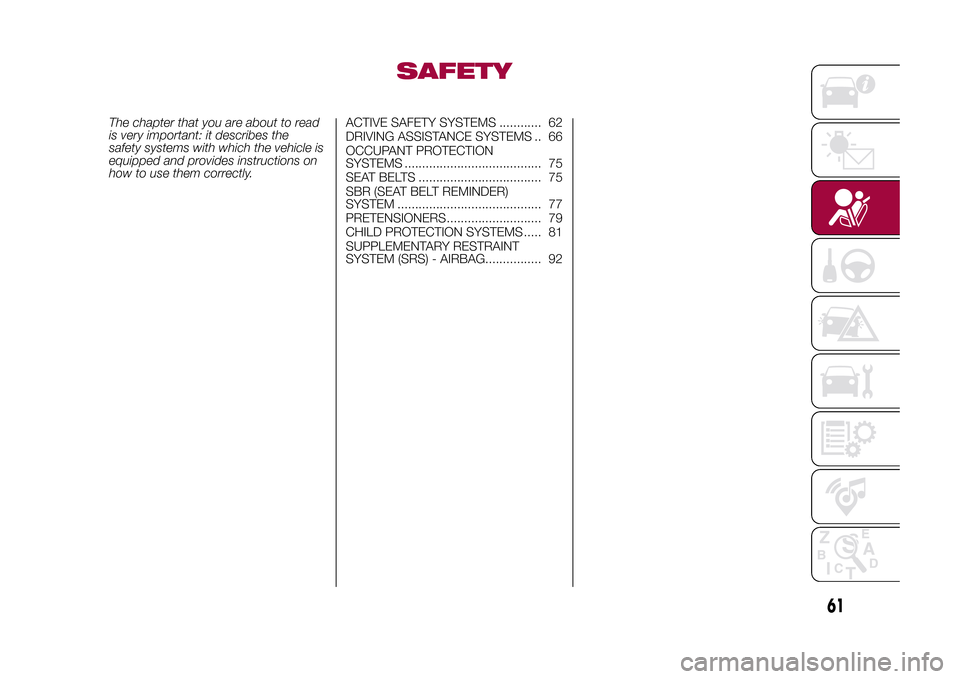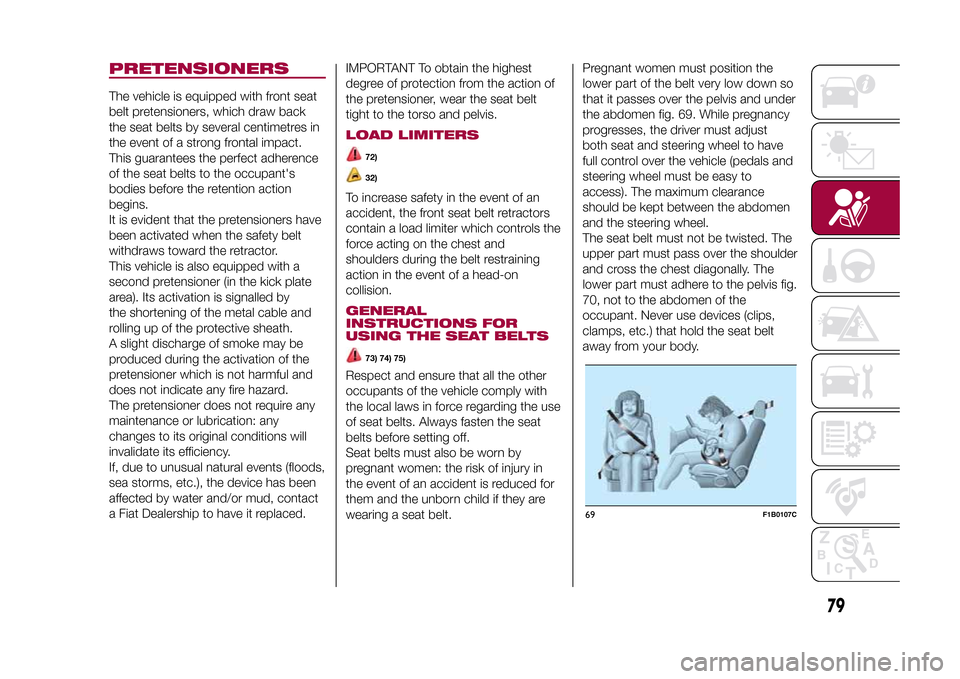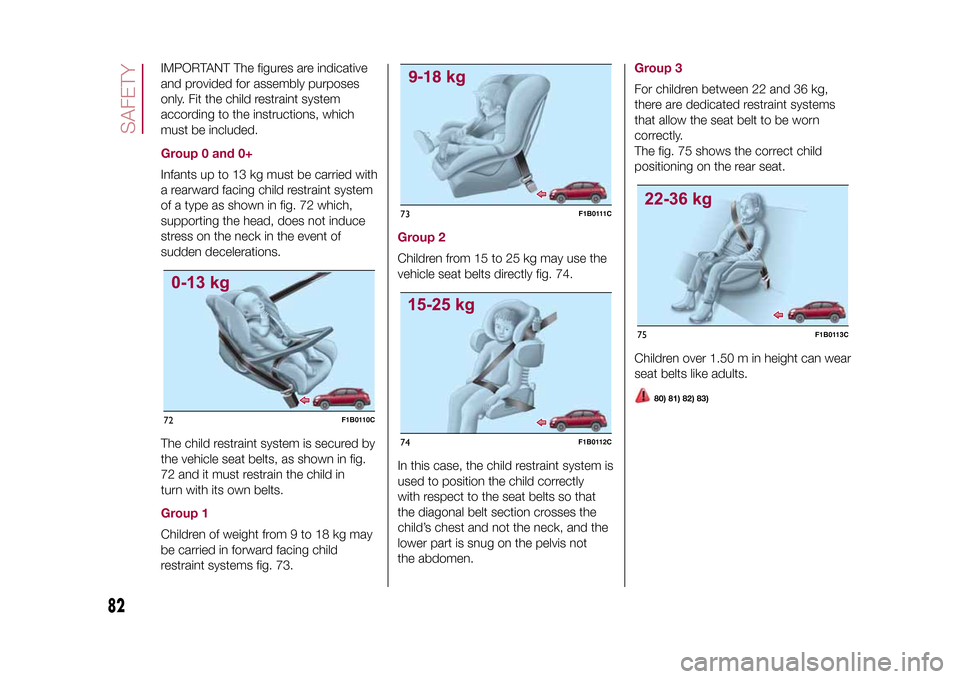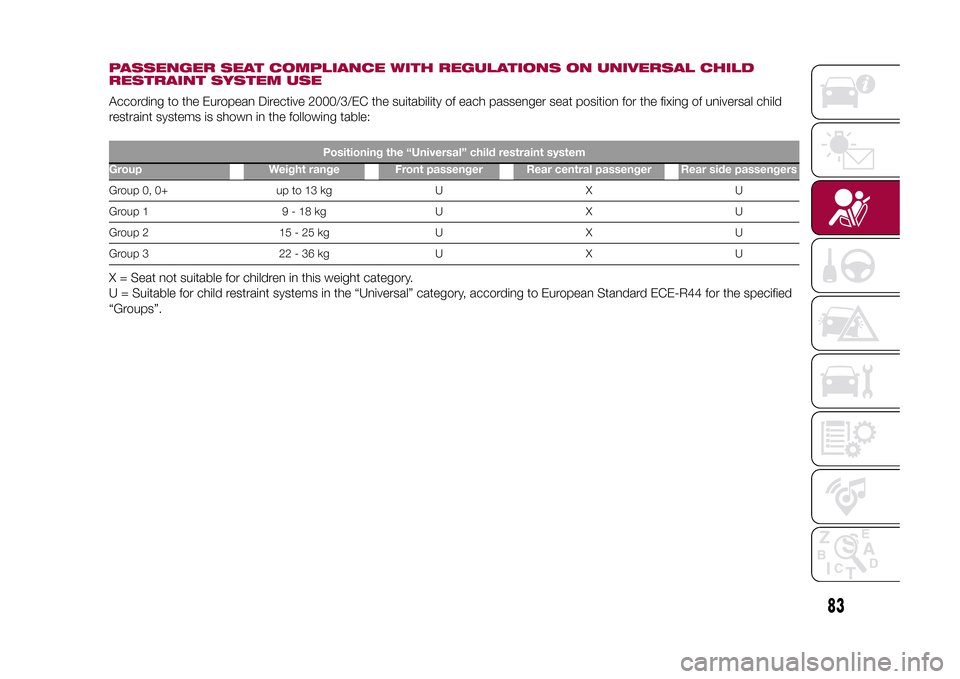2015 FIAT 500X child seat
[x] Cancel search: child seatPage 17 of 240

WARNING
8)Once the Dead Lock system is
engaged, it is impossible to open the
doors from inside the vehicle. Before
getting out of the vehicle, please therefore
check that there is no-one left on board.
9)NEVER leave children unattended inside
the vehicle, nor leave the vehicle with the
doors unlocked in a place that children can
access easily. Children may seriously, or
even fatally, injure themselves. Also ensure
that children do not inadvertently operate
the electric parking brake, the brake pedal
or the automatic transmission lever.
10)Always use this device when carrying
children. After engaging the child lock
on both rear doors, check for proper
engagement by trying to open a rear door
with the internal handle.
WARNING
2)Make sure to take the key with you once
a door or the tailgate is locked, to prevent
locking the same key inside the vehicle.
Once it has been left inside, the key can be
collected only using the second key
supplied.3)The operation of the recognition system
depends on various factors, such as, for
example, any electromagnetic wave
interference from external sources (e.g.
mobile phones), the charge of the battery
in the electronic key and the presence
of metal objects near the key or the vehicle.
In these cases it is still possible to unlock
the doors by using the metal insert in
the electronic key (see description on the
following pages).
SEATSFRONT SEATS WITH
MANUAL ADJUSTMENT
11)4)
Longitudinal adjustmentLift lever A fig. 13 and push the seat
forwards or backwards.
12)
IMPORTANT Carry out the adjustment
while sitting on the seat involved (driver
side or passenger side).13
F1B0019C
15
15-12-2014 8:23 Pagina 15
Page 63 of 240

SAFETY
The chapter that you are about to read
is very important: it describes the
safety systems with which the vehicle is
equipped and provides instructions on
how to use them correctly.ACTIVE SAFETY SYSTEMS ............ 62
DRIVING ASSISTANCE SYSTEMS .. 66
OCCUPANT PROTECTION
SYSTEMS ....................................... 75
SEAT BELTS ................................... 75
SBR (SEAT BELT REMINDER)
SYSTEM ......................................... 77
PRETENSIONERS........................... 79
CHILD PROTECTION SYSTEMS ..... 81
SUPPLEMENTARY RESTRAINT
SYSTEM (SRS) - AIRBAG................ 92
61
15-12-2014 8:23 Pagina 61
Page 77 of 240

31)The Fix&Go automatic quick tyre repair
kit, provided with the vehicle, is compatible
with the iTPMS sensors. Using sealants
different from that in the original kit may
compromise its operation. If sealants not
equivalent with the original ones are used,
it is recommended to have the iTPMS
sensor operation checked by a qualified
repair centre.
OCCUPANT
PROTECTION
SYSTEMSThe most important safety equipment
of the vehicle comprises the following
protection systems:
❒seat belts;
❒SBR (Seat Belt Reminder) system;
❒head restraints;
❒child restraint systems;
❒front airbags and side bags.
Read the information given the
following pages with the utmost care. It
is of fundamental importance that the
protection systems are used in the
correct way to guarantee the maximum
possible safety level for the driver and
the passengers.
For the description of the head restraint
adjustment see paragraph "Head
restraints" in chapter "Knowing your
vehicle".
SEAT BELTSAll vehicle seats are equipped with seat
belts with three anchor points and a
retractor.
The retractor mechanism operates
locking the belt in the event of sharp
braking or strong deceleration due
to an impact. This allows the belt strap
to slide freely and to adapt to the body
of the occupant. In the event of an
accident, the belt will lock reducing the
risk of impact inside the passenger
compartment and of being projected
outside the vehicle.
The driver is responsible for respecting,
and ensuring that all the other
occupants of the vehicle also respect,
the local laws in force in relation to
the use of the seat belts.
Always fasten the seat belts before
setting off.USING THE SEAT BELTSThe seat belt should be worn keeping
the torso straight and rested against
the backrest.
To fasten the seat belts, hold tongue A
fig. 63 and insert it into buckle B, until
it clicks into place.
On removal of the belt, if it jams, let it
rewind for a short stretch, then pull
it out again without jerking.
75
15-12-2014 8:23 Pagina 75
Page 81 of 240

PRETENSIONERSThe vehicle is equipped with front seat
belt pretensioners, which draw back
the seat belts by several centimetres in
the event of a strong frontal impact.
This guarantees the perfect adherence
of the seat belts to the occupant's
bodies before the retention action
begins.
It is evident that the pretensioners have
been activated when the safety belt
withdraws toward the retractor.
This vehicle is also equipped with a
second pretensioner (in the kick plate
area). Its activation is signalled by
the shortening of the metal cable and
rolling up of the protective sheath.
A slight discharge of smoke may be
produced during the activation of the
pretensioner which is not harmful and
does not indicate any fire hazard.
The pretensioner does not require any
maintenance or lubrication: any
changes to its original conditions will
invalidate its efficiency.
If, due to unusual natural events (floods,
sea storms, etc.), the device has been
affected by water and/or mud, contact
a Fiat Dealership to have it replaced.IMPORTANT To obtain the highest
degree of protection from the action of
the pretensioner, wear the seat belt
tight to the torso and pelvis.
LOAD LIMITERS
72)32)
To increase safety in the event of an
accident, the front seat belt retractors
contain a load limiter which controls the
force acting on the chest and
shoulders during the belt restraining
action in the event of a head-on
collision.GENERAL
INSTRUCTIONS FOR
USING THE SEAT BELTS
73) 74) 75)
Respect and ensure that all the other
occupants of the vehicle comply with
the local laws in force regarding the use
of seat belts. Always fasten the seat
belts before setting off.
Seat belts must also be worn by
pregnant women: the risk of injury in
the event of an accident is reduced for
them and the unborn child if they are
wearing a seat belt.Pregnant women must position the
lower part of the belt very low down so
that it passes over the pelvis and under
the abdomen fig. 69. While pregnancy
progresses, the driver must adjust
both seat and steering wheel to have
full control over the vehicle (pedals and
steering wheel must be easy to
access). The maximum clearance
should be kept between the abdomen
and the steering wheel.
The seat belt must not be twisted. The
upper part must pass over the shoulder
and cross the chest diagonally. The
lower part must adhere to the pelvis fig.
70, not to the abdomen of the
occupant. Never use devices (clips,
clamps, etc.) that hold the seat belt
away from your body.
69
F1B0107C
79
15-12-2014 8:23 Pagina 79
Page 82 of 240

Each seat belt must be used by only
one person. Never travel with a child
sitting on the passenger's lap and
a single belt to protect them both fig.
71. In general, do not place any objects
between the person and the belt.
SEAT BELTS
MAINTENANCEFor keeping the seat belts in efficient
conditions, carefully observe the
following warnings:
❒always use the seat belt well
stretched and never twisted; make sure
that it is free to run without
obstructions;
❒check seat belt operation as follows:
attach the seat belt and pull it hard;
❒replace the belt after an accident of a
certain severity even if it does not
appear to be damaged. Always replace
the seat belt if the pretensioners were
deployed;
❒to clean the seat belts, wash by hand
with water and neutral soap, rinse and
leave to dry in the shade. Never use
strong detergents, bleach, paints or any
other chemical substance which could
damage the belt fibres;
❒prevent the retractors from getting
wet: their correct operation is only
guaranteed if water does not get inside;
❒replace the seat belt when it shows
wear or cuts.
WARNING
72)The pretensioner may be used only
once. Contact a Fiat Dealership to have it
replaced after it has been deployed.
73)Removing or otherwise tampering with
seat belt and pretensioner components
is strictly prohibited. Any intervention
on these components must be performed
by qualified and authorised technicians.
Always contact a Fiat Dealership.
74)For maximum safety, keep the back of
your seat upright, lean back into it and
make sure the seat belt fits closely across
your torso and pelvis. Always fasten the
seat belts for both the front and rear seats!
Travelling without wearing seat belts will
increase the risk of serious injury and even
death in the event of an accident.
75)If the belt has been subjected to heavy
strain, for example after an accident, it
must changed completely together with the
anchors, anchor fastening screws and the
pretensioner. Even if the belt has no visible
defects, it could have lost its resilience.
WARNING
32)Operations which lead to impacts,
vibrations or localised heating (over 100°C
for a maximum of six hours) in the area
around the pretensioner may damage or
deploy it. Contact a Fiat Dealership should
intervention be necessary on these
components.
70
F1B0108C
71
F1B0109C
80
SAFETY
15-12-2014 8:23 Pagina 80
Page 83 of 240

CHILD PROTECTION
SYSTEMSCARRYING CHILDREN
SAFELY
76) 77) 78) 79)
For optimal protection in the event of an
impact, all occupants must be seated
and wearing adequate restraint
systems, including newborn and other
children!
This prescription is compulsory in all EC
countries according to EC Directive
2003/20/EC.
Children below the height of 1.50
metres and up to 12 years must be
protected with suitable restraint
systems and be seated on the rear
seats.
Statistics on accidents indicate that the
rear seats offer greater safety for
children.
Compared with an adult, a child's head
is larger and heavier in proportion to
their body and the child's muscular and
bone structures are not fully developed.
Therefore, correct restraint systems
other than adult seat belts are
necessary, to reduce as much as
possible the risk of injuries in the event
of an accident, braking or sudden
manoeuvre.Children must be seated safely and
comfortably. Depending on the
characteristics of the child restraint
systems used, you are advised to keep
children in rearward facing child
restraint systems for as long as
possible (at least until 3–4 years old),
since this is the most protected position
in the event of an impact.
The choice of the most suitable child
restraint system depends on the weight
and size of the child. There are various
types of child restraint systems, which
can be secured to the vehicle by means
of the seat belts or with the ISOFIX/i-
Size anchorages.
It is recommended to always choose
the restraint system most suitable
for the child; for this reason always refer
to the Owner Handbook provided with
the child restraint system, to be sure
that it is of the right type for the children
it is intended for.
In Europe the characteristics of child
restraint systems are ruled by the
regulation ECE-R44, dividing them into
five weight groups:
Group Weight rangeGroup0 upto10kg
Group 0+ up to 13 kg
Group 1 9 - 18 kg
Group Weight rangeGroup 2 15 - 25 kg
Group 3 22 - 36 kgThe ECE-R44 standard was recently
paired with the ECE R-129 regulation,
which defines the characteristics of
the new i-Size child restraint systems
(see the "Suitability of passenger seats
for i-Size child restraint system use"
paragraph for more information).
All restraint devices must bear the
certification data, together with the
control mark, on a label solidly fixed to
the child restraint system which must
never be removed.
Lineaccessori MOPAR
®includes child
restraint systems for each weight
group. These devices are
recommended having been specifically
designed for Fiat vehicles.
FITTING A CHILD
RESTRAINT SYSTEM
WITH SEAT BELTSThe Universal child restraint systems
installed with the seat belts only are
type-approved on the basis of the ECE
R44 standard and are divided into
various weight groups.
81
15-12-2014 8:23 Pagina 81
Page 84 of 240

IMPORTANT The figures are indicative
and provided for assembly purposes
only. Fit the child restraint system
according to the instructions, which
must be included.Group 0 and 0+Infants up to 13 kg must be carried with
a rearward facing child restraint system
of a type as shown in fig. 72 which,
supporting the head, does not induce
stress on the neck in the event of
sudden decelerations.
The child restraint system is secured by
the vehicle seat belts, as shown in fig.
72 and it must restrain the child in
turn with its own belts.Group 1Children of weight from 9 to 18 kg may
be carried in forward facing child
restraint systems fig. 73.
Group 2Children from 15 to 25 kg may use the
vehicle seat belts directly fig. 74.
In this case, the child restraint system is
used to position the child correctly
with respect to the seat belts so that
the diagonal belt section crosses the
child’s chest and not the neck, and the
lower part is snug on the pelvis not
the abdomen.
Group 3For children between 22 and 36 kg,
there are dedicated restraint systems
that allow the seat belt to be worn
correctly.
The fig. 75 shows the correct child
positioning on the rear seat.
Children over 1.50 m in height can wear
seat belts like adults.
80) 81) 82) 83)
72
F1B0110C
73
F1B0111C
74
F1B011 2C
75
F1B0113C
82
SAFETY
15-12-2014 8:23 Pagina 82
Page 85 of 240

PASSENGER SEAT COMPLIANCE WITH REGULATIONS ON UNIVERSAL CHILD
RESTRAINT SYSTEM USEAccording to the European Directive 2000/3/EC the suitability of each passenger seat position for the fixing of universal child
restraint systems is shown in the following table:
Positioning the “Universal” child restraint system
Group Weight range Front passenger Rear central passenger Rear side passengers
Group 0, 0+ up to 13 kg U X U
Group 1 9 - 18 kg U X U
Group 2 15 - 25 kg U X U
Group 3 22 - 36 kg U X UX = Seat not suitable for children in this weight category.
U = Suitable for child restraint systems in the “Universal” category, according to European Standard ECE-R44 for the specified
“Groups”.
83
15-12-2014 8:23 Pagina 83